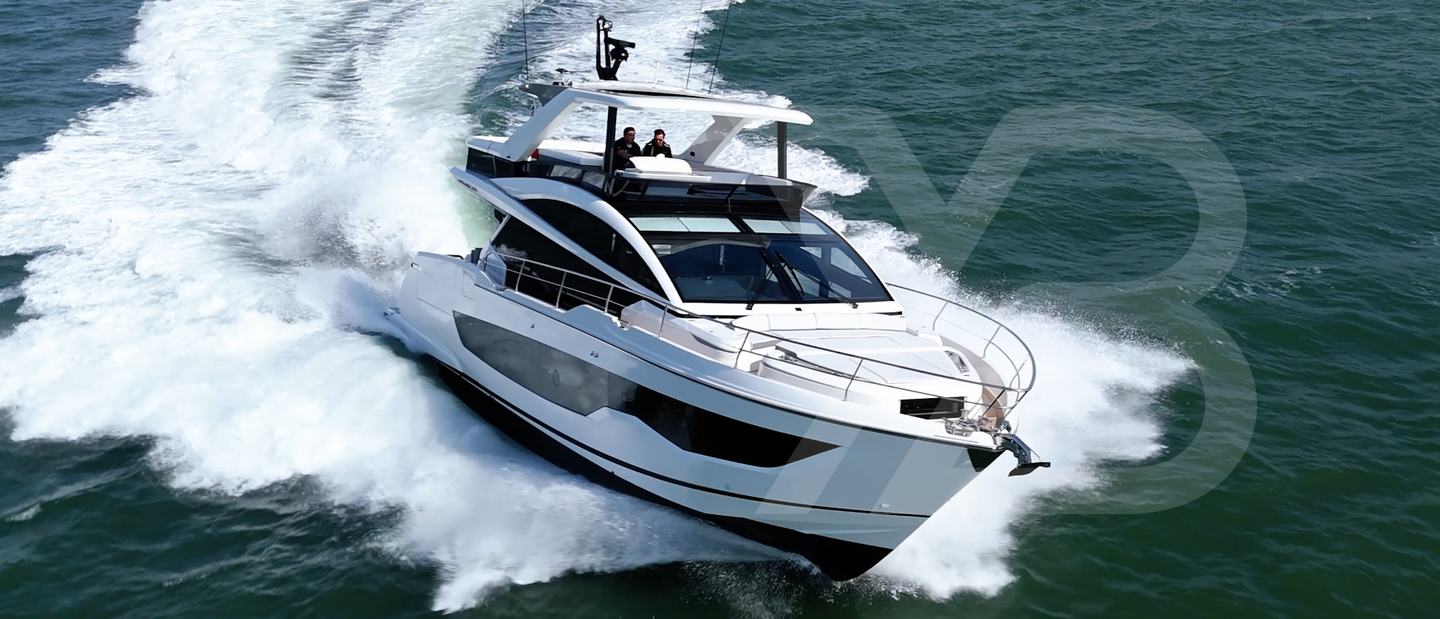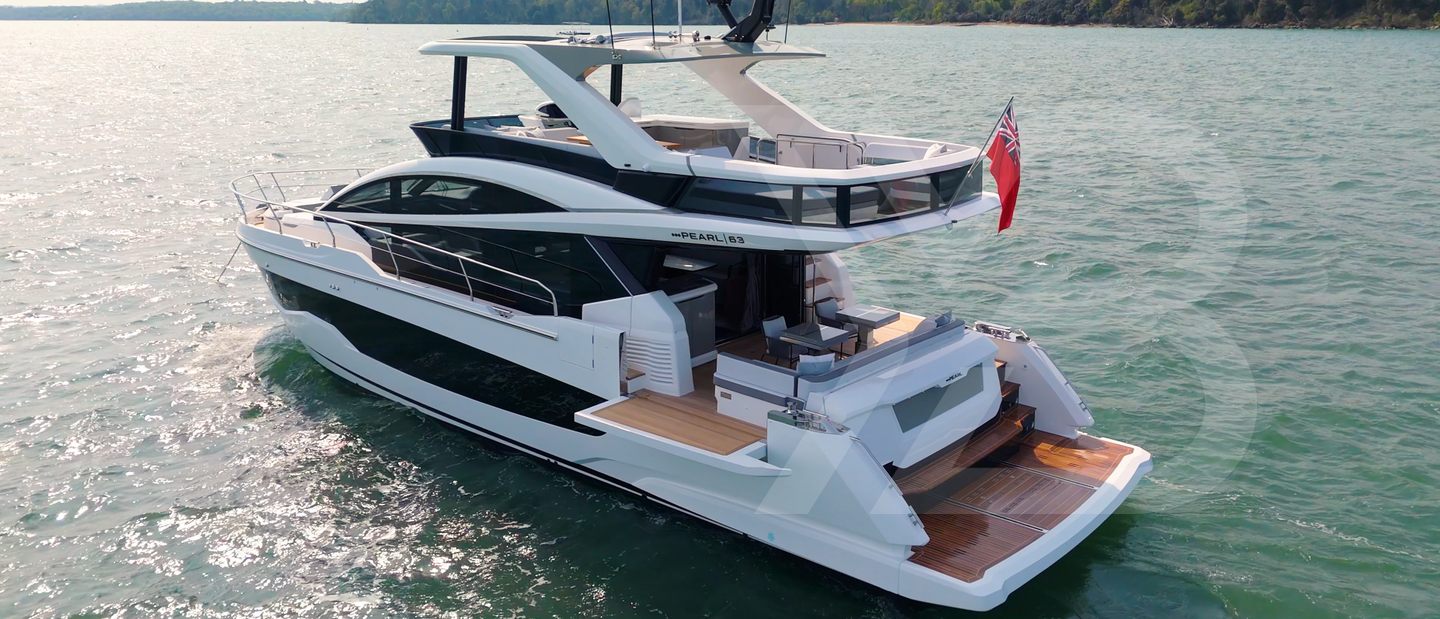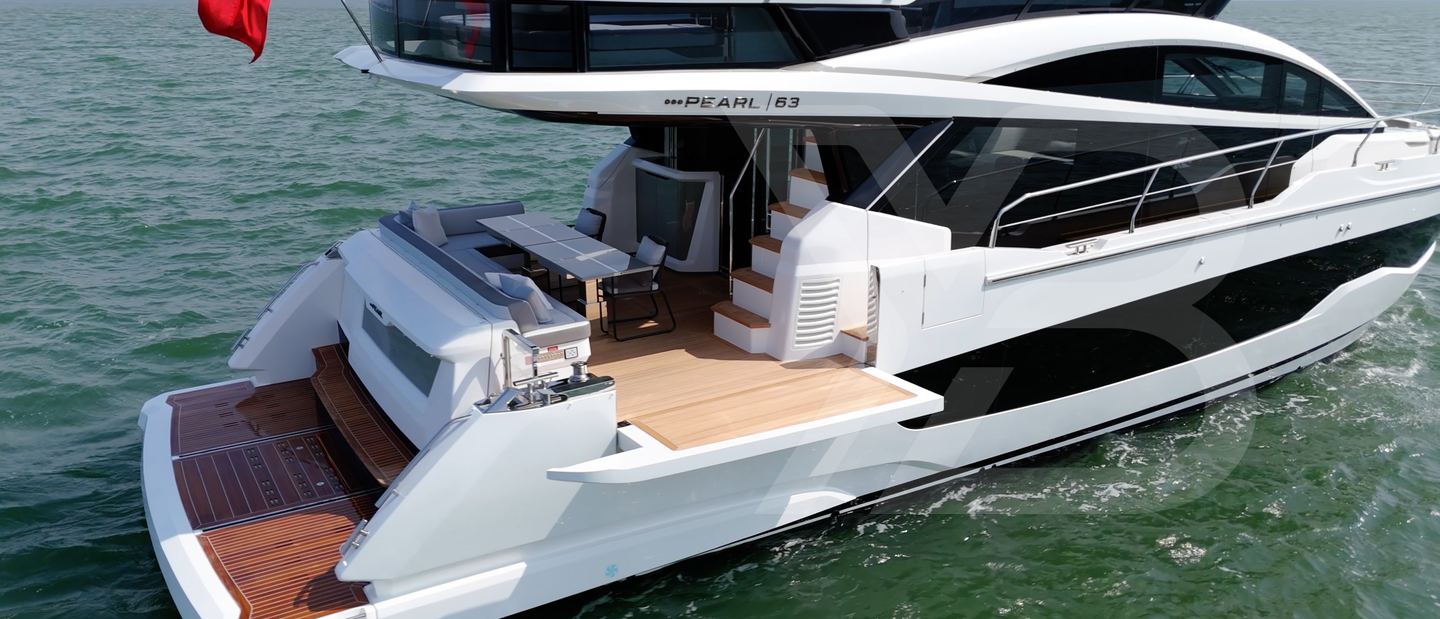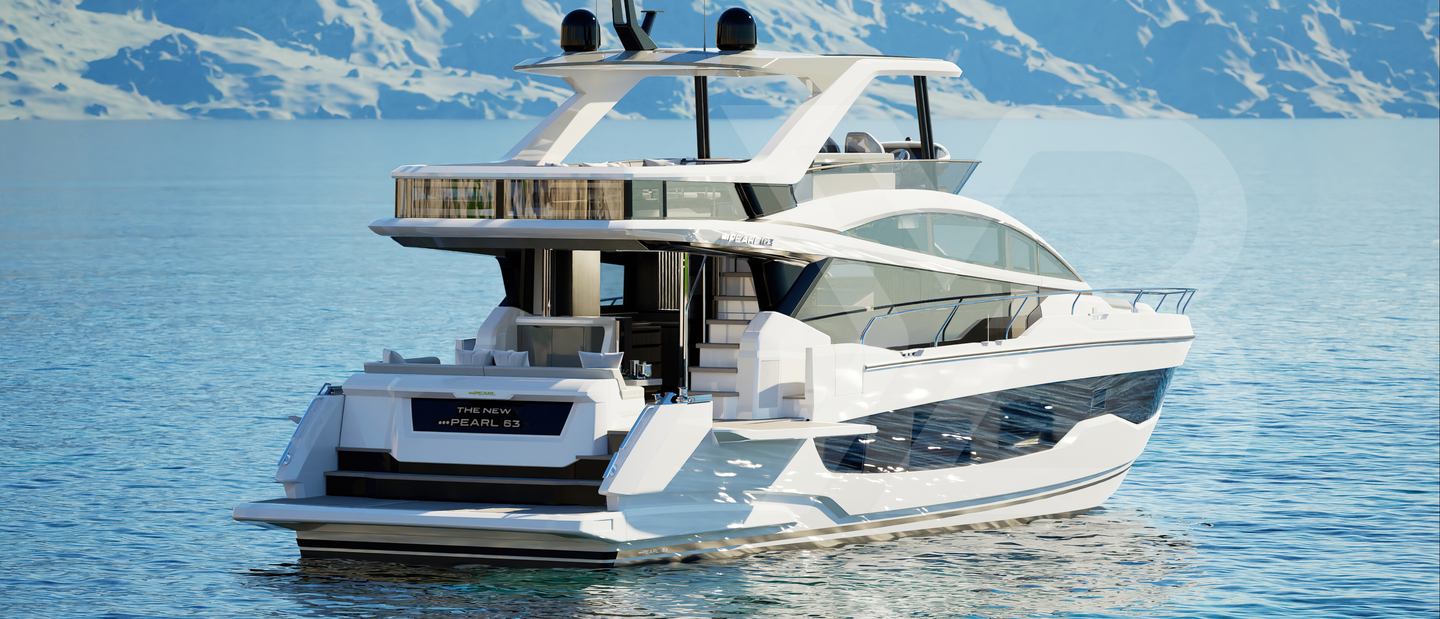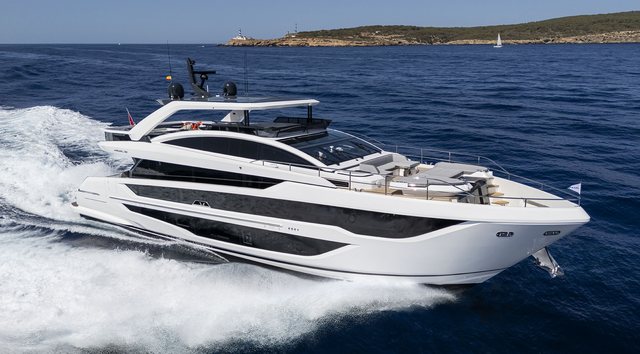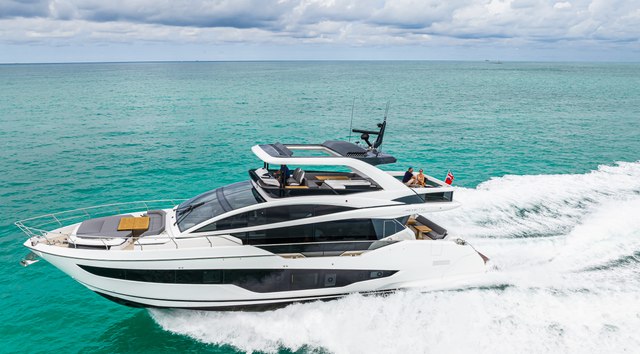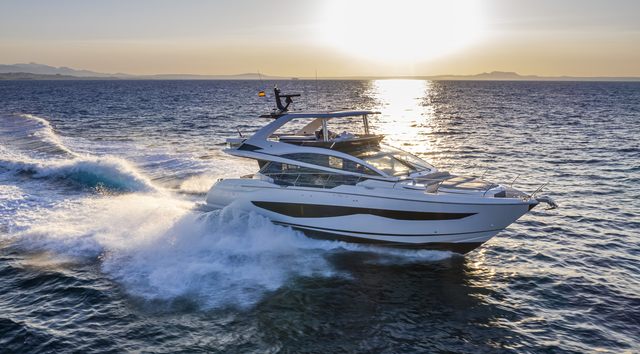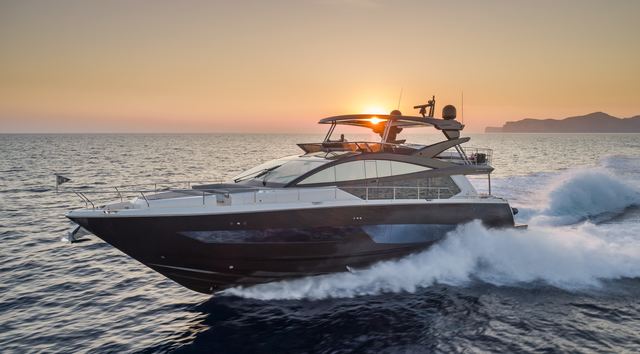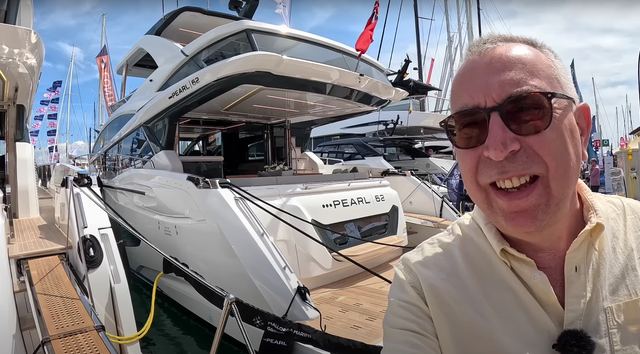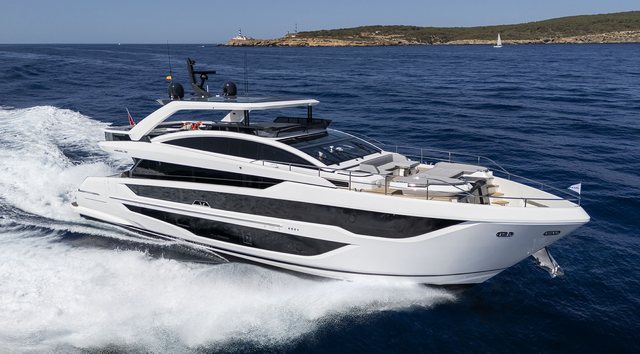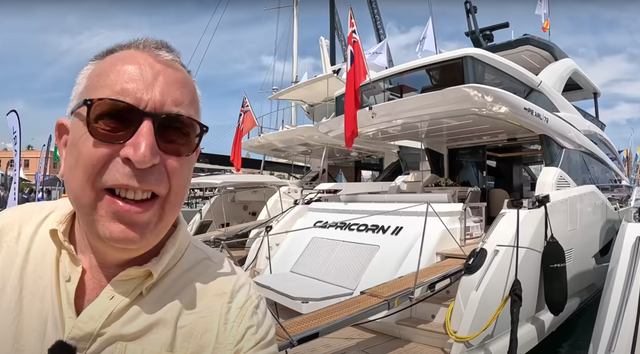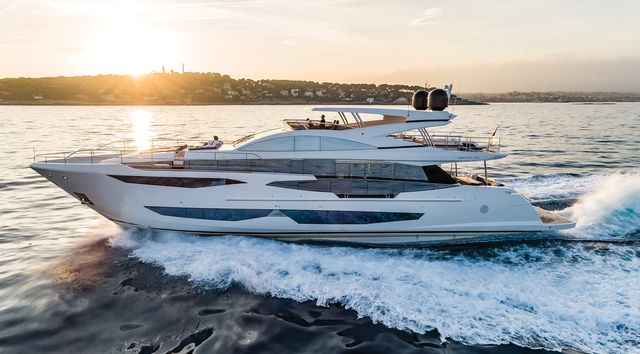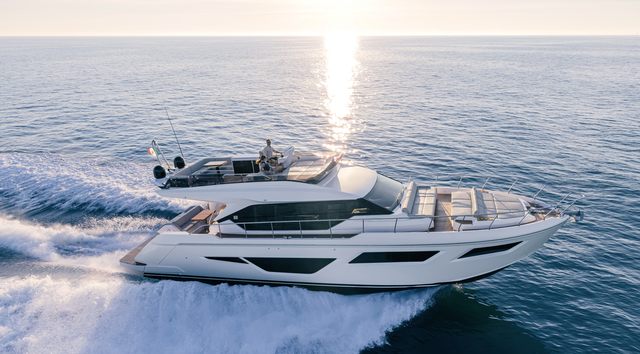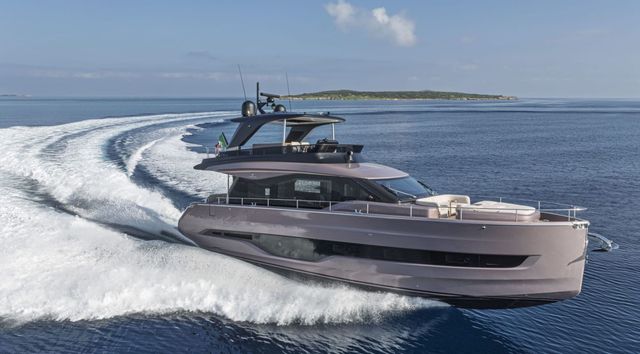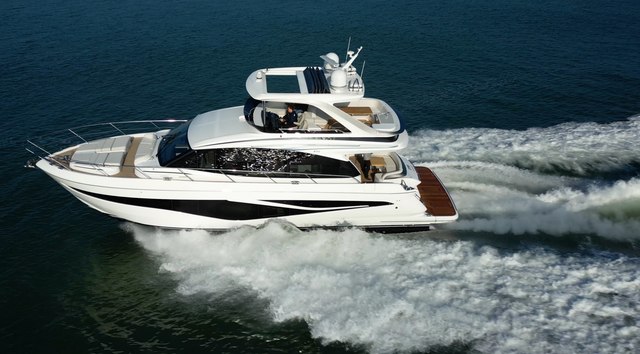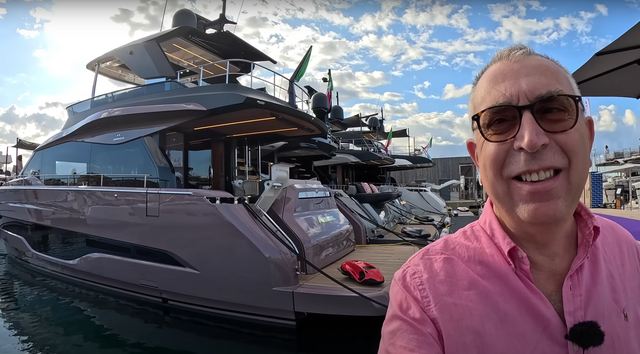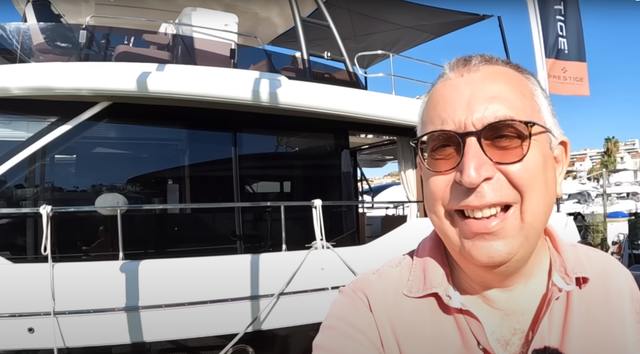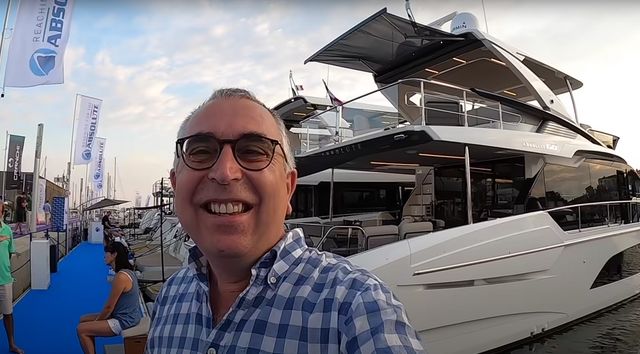Designing the follow-up to your most successful model is no small task. Just ask Bill Dixon, the man behind the Pearl 62 – a 60-foot flybridge that squeezed in four cabins, three bathrooms, and a tender garage large enough for a jet ski. A rare layout in this size, and a big reason it became Pearl’s bestseller.
So when Pearl called to ask, “Can you make it even better?” the brief was clear – don’t reinvent it, refine it. And this is the result: the new Pearl 63. Can the 63 possibly improve the formula of the most successful boat Pearl has ever made? Read on to find out.
Pearl 63 Key Facts

- LOA 61.056ft
- Model Year 2025
- Cabins 4
- Crew 1
- Max Speed 33 knots
- Status In Production
- Yacht Type Flybridge
- Use Type Weekending
Test & Review Video
Around the Marina
The Pearl 63 is firmly in the category of owner/operator, and therefore, handling around the marina is a very important part of the package. All three engine options are Volvo Penta IPS so whichever you go for, you'll get joystick control,l which makes manoeuvring around the marina a bit easier. Adding DPS (Dynamic Positioning System) makes a big difference, too, meaning you can hold the boat in place and hang fenders and lines safe in the knowledge it isn't going to move anywhere.
There is the option to add a joystick and thruster control in the cockpit - great for stern-to-mooring - but in the UK marina we were berthing in, I opted to handle the boat from the flybridge. The flybridge helm is a long way forward, and the wet bar is behind it, so it's hard to see the bathing platform from this helm. However, there is a camera mounted over the bathing platform that feeds to the Garmin MFD, and the aft end of the flybridge has glazing in it, meaning you can see aft pretty comfortably from this position.
The boat handles nicely on the joystick, but as always, I would spec a bow thruster for fine adjustment of the boat without having to always rely on the joystick.
When it comes to crewing, the boat is well-designed. The side decks are wide and safe, and deck storage is excellent. All of the boat's fenders fit in the anchor locker, and there are lockers on either side of the windscreen that swallow the lines, so everything is neatly contained in one area of the boat.
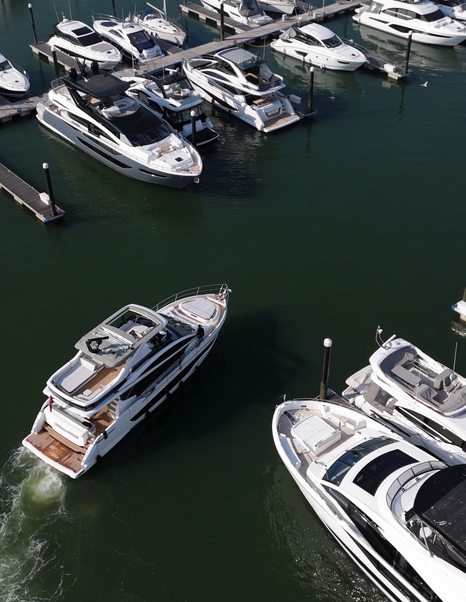
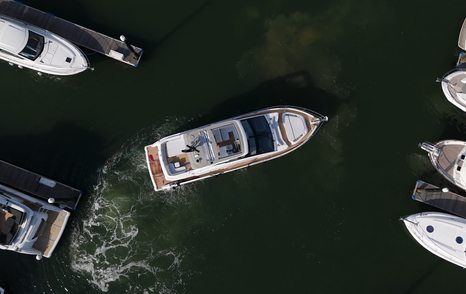
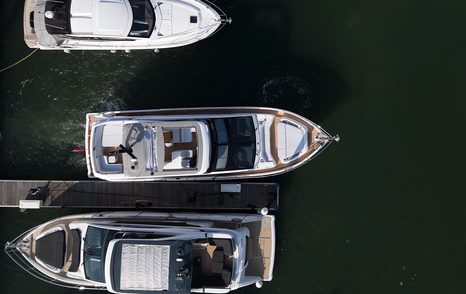
At Sea
The IPS1350s with 1,000hp per side feel spot on for this size and style of boat. Compared to the Pearl 62, which topped out at 31 knots, the 63 edges that up to around 33 knots. Not that top speed is the headline here - it’s more about how it cruises. And at 22-25 knots, it feels in its element, delivering a fast cruising range of around 260nm. Ease off the pace and you’ll stretch that range much further.
It’s fitted with a Seakeeper gyroscopic stabiliser rather than fins, so you lose a bit of effect at speed, but it settles well at displacement pace - happy pottering along at 12 knots on a calm day. Push up to 24 knots, and it still feels composed. Pearl mentioned they weren’t totally happy with the steering on this first hull and planned to fine-tune it with Volvo. But as it is, the steering’s light and responsive, with trim assist and Seakeeper both engaged. You can sharpen it up a touch by switching those off, but for most owners, leaving them on will suit just fine.
It’s not trying to be a sports boat, and doesn’t need to be. This platform is familiar territory for Pearl, who’ve delivered plenty of 62s. The 63 feels well-resolved - easy to drive at speed, responsive to the helm, and impressively refined. A Princess F58 might be sharper to handle, but for a boat with this brief, the Pearl 63 delivers.
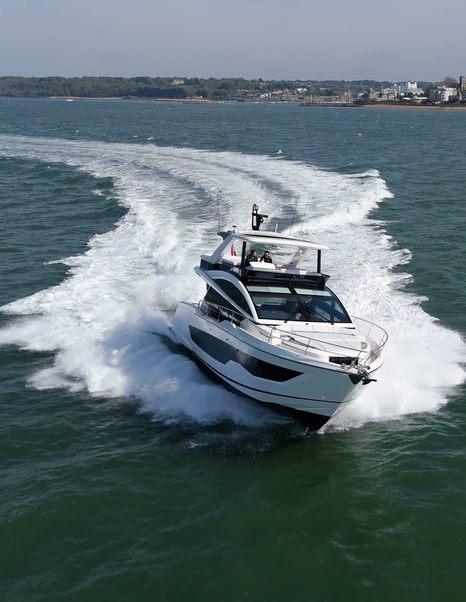
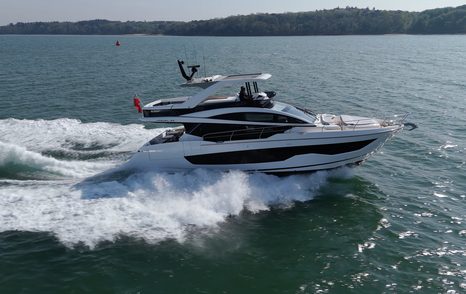
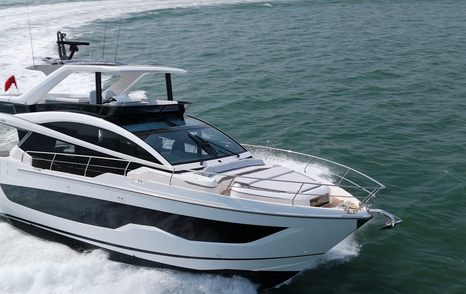
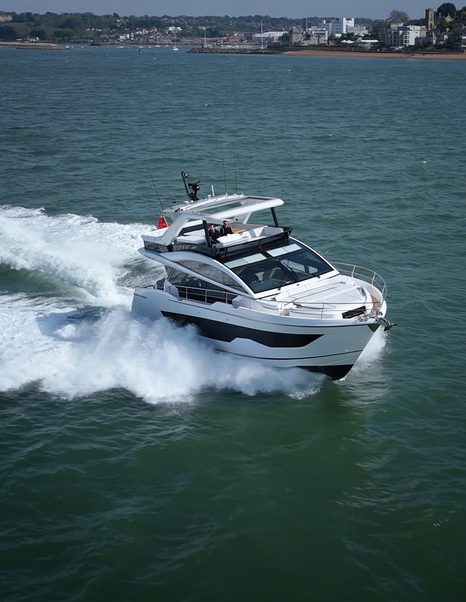
The Pearl 63 builds directly on the platform of the Pearl 62, retaining its core layout and IPS propulsion while introducing a wide range of thoughtful upgrades. This isn’t a full redesign, as it didn't need one, but a series of smart tweaks that sharpen the looks, boost usability, and make day-to-day life on board that much smoother. Most obviously, the exterior profile has been cleaned up, with sleeker hull glazing and the addition of new drop-down balconies in the cockpit. These folding terraces are optional but well worth it, opening the aft deck right up and creating a more inviting space at anchor. They’re supported by a revised layout with twin adjustable tables and a sliding backrest, so you can now angle the seating aft and soak up the view.
The tender garage also gets an upgrade. It's a little longer than on the 62, which means it can now accommodate a semi-inflated Williams MiniJet instead of just a Jet Ski. You can still go with the Jet Ski on the platform if you prefer, but the flexibility to store a proper tender inside is a big win.

Up top, the flybridge layout stays much the same, which makes sense - it's always been a strong area - but you can now spec it with flexible furniture modules, an optional ice maker, and a canvas sunroof over the hardtop to add some extra comfort. A similar story unfolds on the foredeck. The layout is unchanged, but the detailing has been improved, with better finishes, integrated storage, and the option to add a canopy for shade.
Inside, the updates are more noticeable. The saloon has a more open layout, with an extended dinette, a relaxed chaise lounge opposite, and pull-out stools that double as storage. This arrangement splits lounging and dining properly, and the stools can be moved around to suit. The aft galley links more effectively to the cockpit now, thanks to the drop-down window that completes the counter run. This isn’t a new idea, but it works well here, giving you a proper indoor-outdoor flow without messing with the cabinetry.
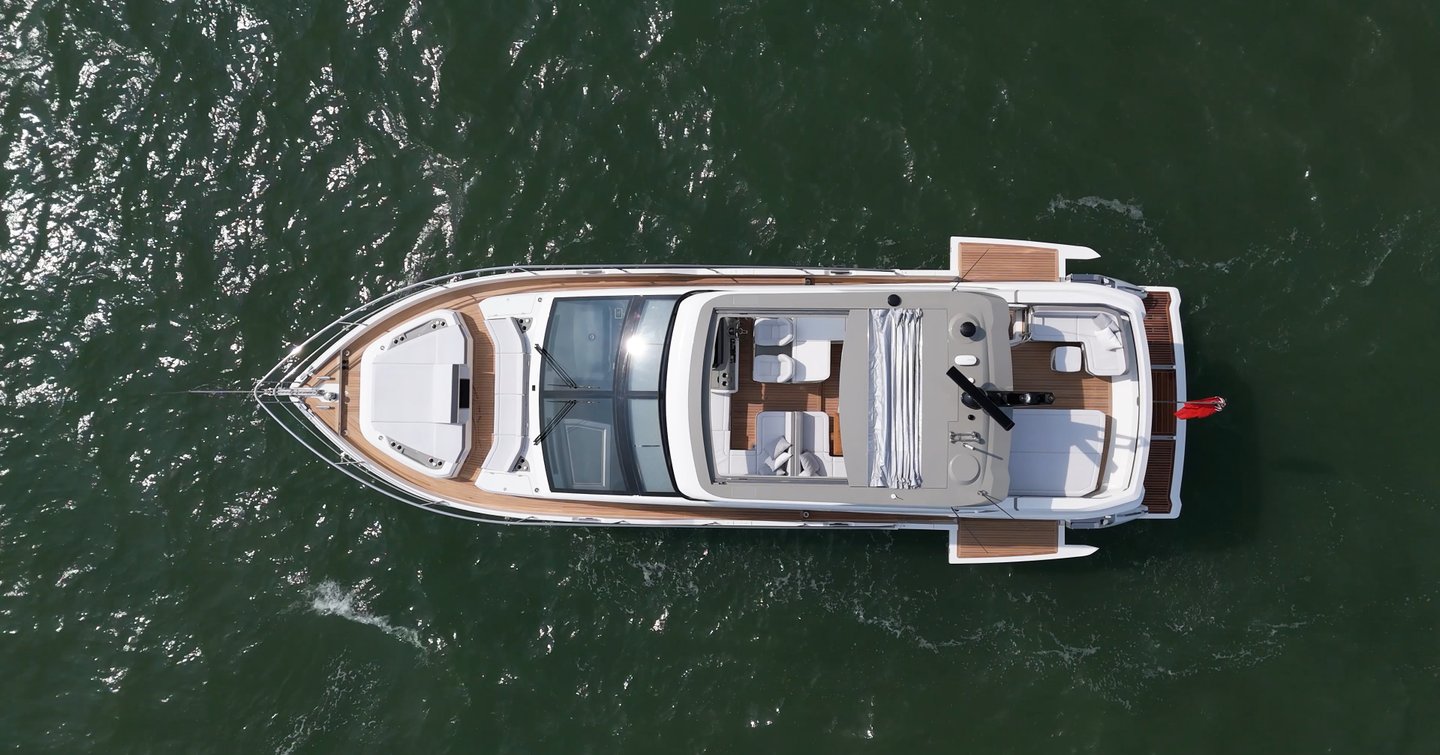
Styling throughout has softened. Whereas early Kelly Hoppen interiors had sharp angles, the 63 leans into rounded forms and a more nautical feel. There are four interior themes to choose from, all designed by Hoppen: Indulgence, which features darker, richer tones; Modern, which is light and airy with neutral textures; Luxury, which combines deeper colours with metallic accents; and Monochrome.
Our test boat had Indulgence, and that leans darker and more luxurious. Materials feel solid, storage has been carefully worked in, and lighting design has taken a step forward too. Continuous strip lights have replaced pin spots on deck, and inside, backlit features give key elements a bit of presence without overdoing it.
The owner’s cabin keeps its private stair access and full-beam layout, but the detailing is improved here too. Lighting has been upgraded, cabinetry refined, and the finish feels more polished. There’s also an option to switch the small seating area for a breakfast dinette, a sensible tweak for longer stays on board. The VIP and twin guest cabins forward carry over from the 62, with subtle updates like improved headroom, sliding infill for the twins to convert them into doubles, and slightly smarter use of hull window placements to bring in more natural light.
Both helm stations have been tweaked for better ergonomics. The lower helm has been moved slightly inboard, improving visibility and making the most of the curved windscreen overhead. Joystick controls come as standard, and there’s the option to add a bow thruster.
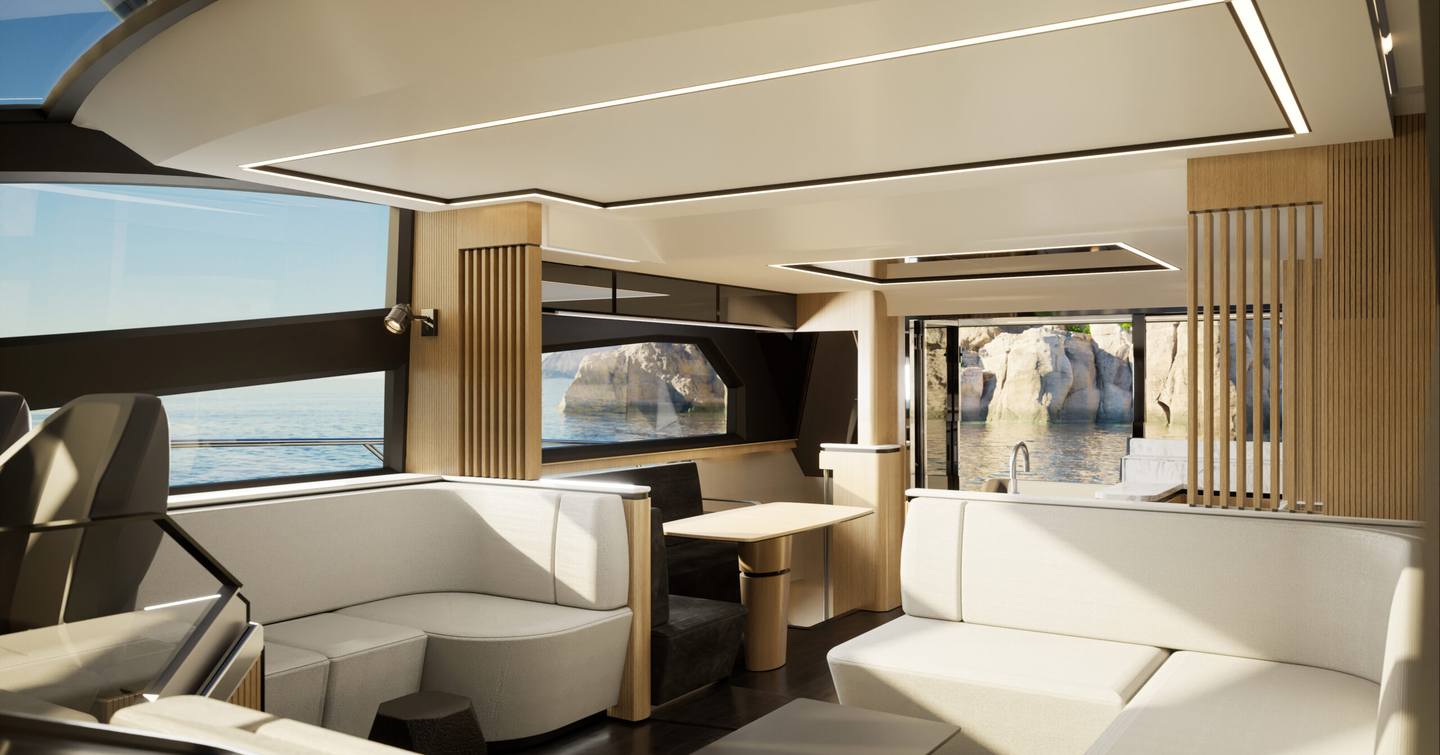
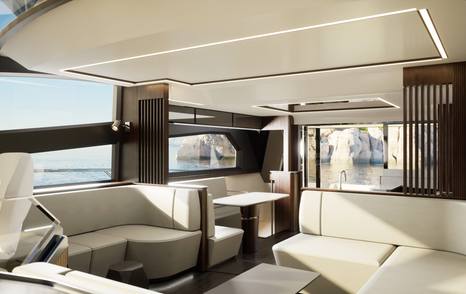
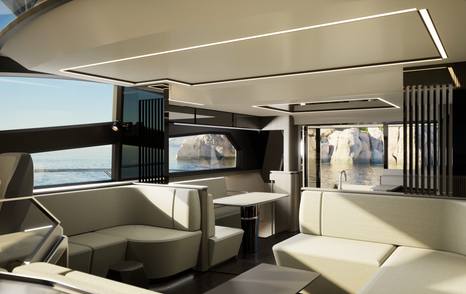
Engine Room
You’d expect to find some compromise when fitting four cabins and a tender garage into a 61ft boat, but it’s not in the engine room.
There’s a slight intrusion from the tender garage near the hatch, but it doesn’t eat into the space in any meaningful way. The headroom holds up well - a little tighter in places, but still easy to move around. There’s clear access to the engines, with the generator forward and filters mounted neatly on the bulkhead. The layout is clean and logical - pipework and cabling are all clipped, labelled, and easy to inspect at a glance.
You do need to crouch slightly to reach the aft end, but even then, access to the pods is straightforward. This could have been the area where the layout felt pinched, where the balance tipped too far - but it isn’t. The engine room on the Pearl 63 is well laid out and properly finished, and another reminder of how considered the whole package is.

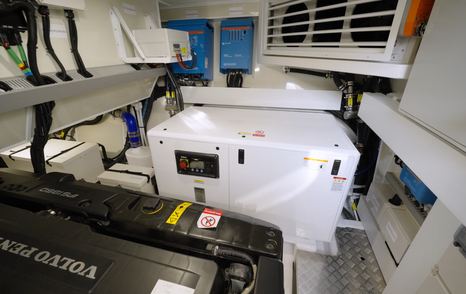

At the aft end of the saloon, a set of sliding cockpit doors is paired with a drop-down window, linking the galley directly to the exterior. This isn’t new tech, but it works well in this setup. Drop the window, fold out the second section, and the counter extends into the cockpit - a quick, simple transformation that gives you an open, breezy connection between indoor and out. It makes serving effortless and opens up the aft galley to the view.
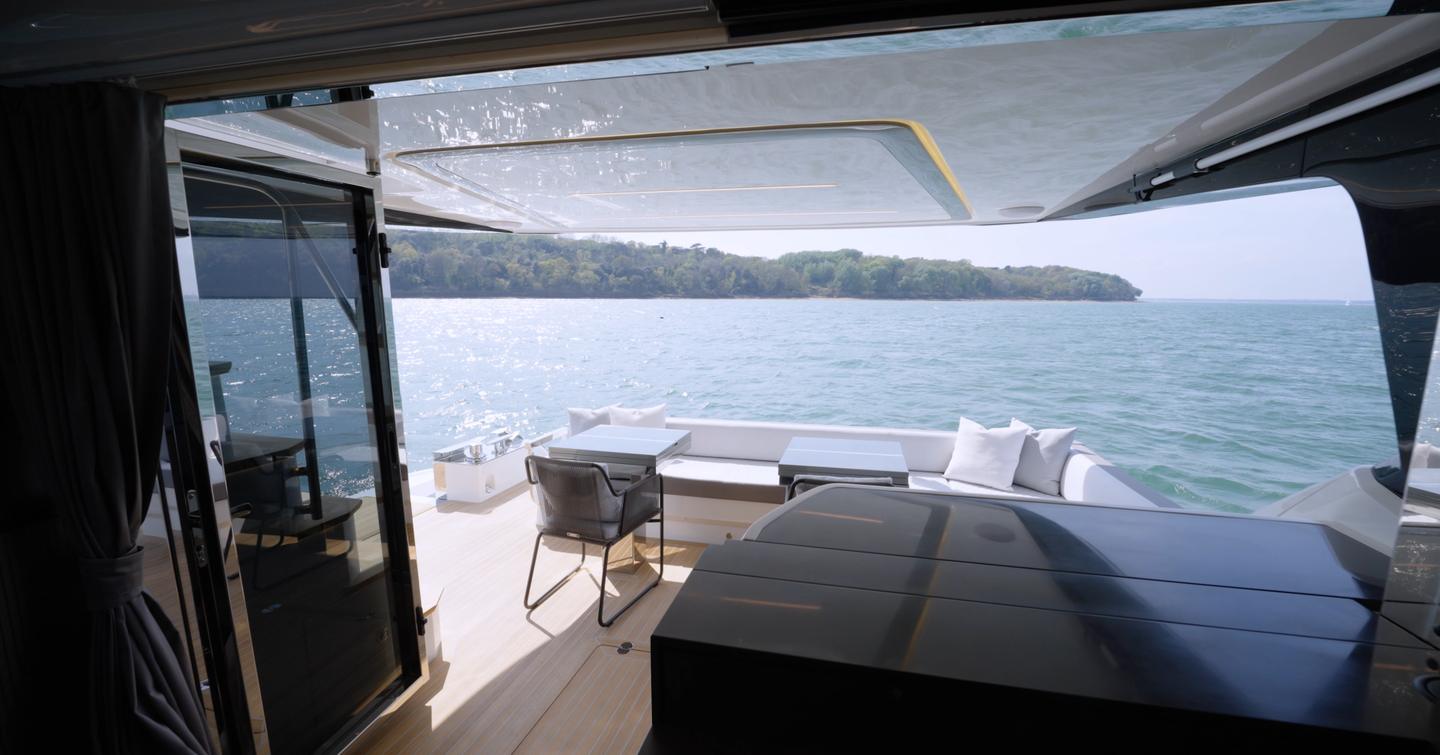
The galley itself is well equipped, with everything having its own dedicated spot - plates, glasses, even the Pearl-branded cutlery has its place. There’s Miele induction cooking, an oven underneath, a dishwasher, and loads of storage throughout. The fridge-freezer is a good size, though the freezer has a proper catch and the fridge doesn’t - worth remembering if you’re packing heavy items before going to sea.
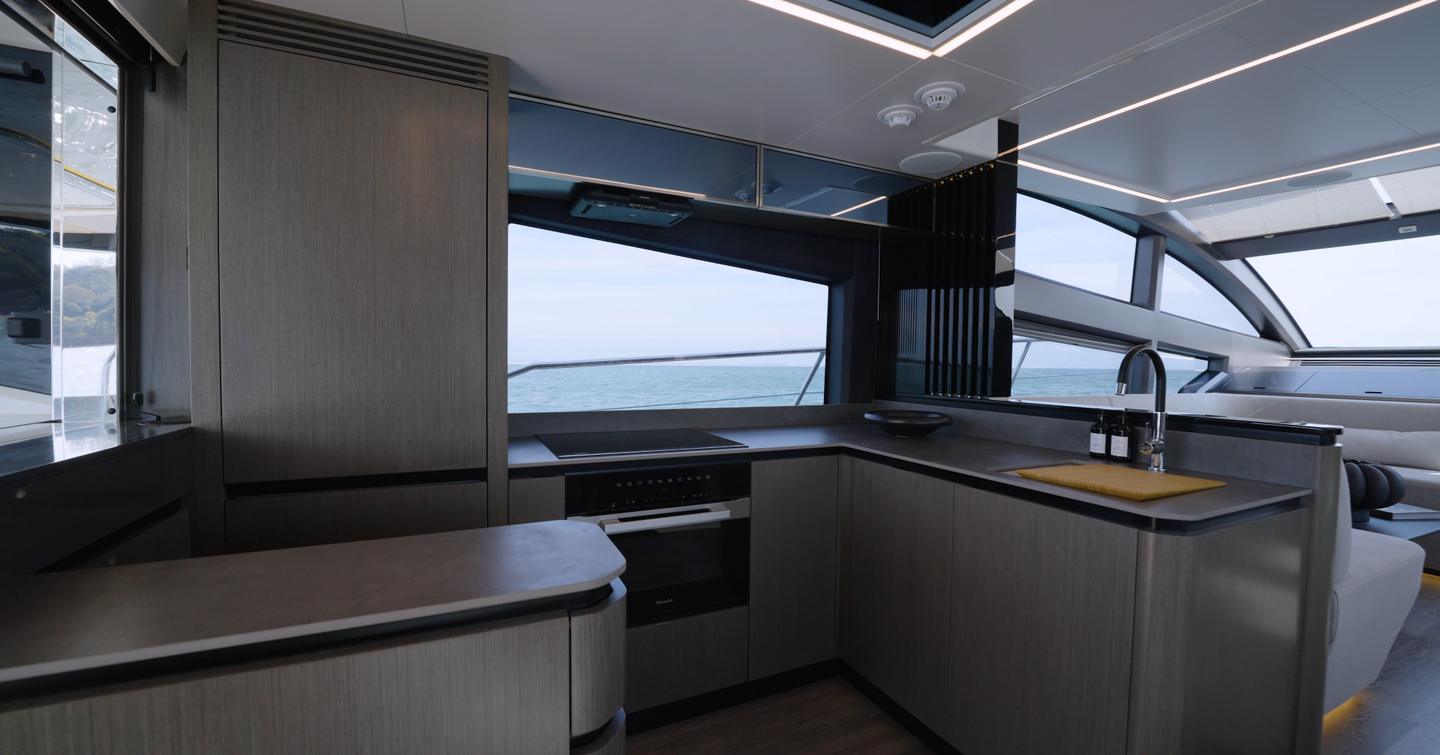
One of the notable changes from the 62 to the 63 is the reworked dinette. On the 62, this area felt a little tight, but by extending it forward, there’s now room for four to sit comfortably. It also gives the space a clearer identity - this is now the dedicated dining area onboard, separate from the lounging zone opposite. The high backrest works well for dining or using a laptop.
If needed, the setup can expand - two additional stools can be placed opposite to seat six in total. Each stool has a removable lid with a deep compartment inside for stowing away smaller items. They can also be used opposite the coffee table or repositioned to the dinette, depending on how the space is being used. When not needed, they join together as a compact bench module.
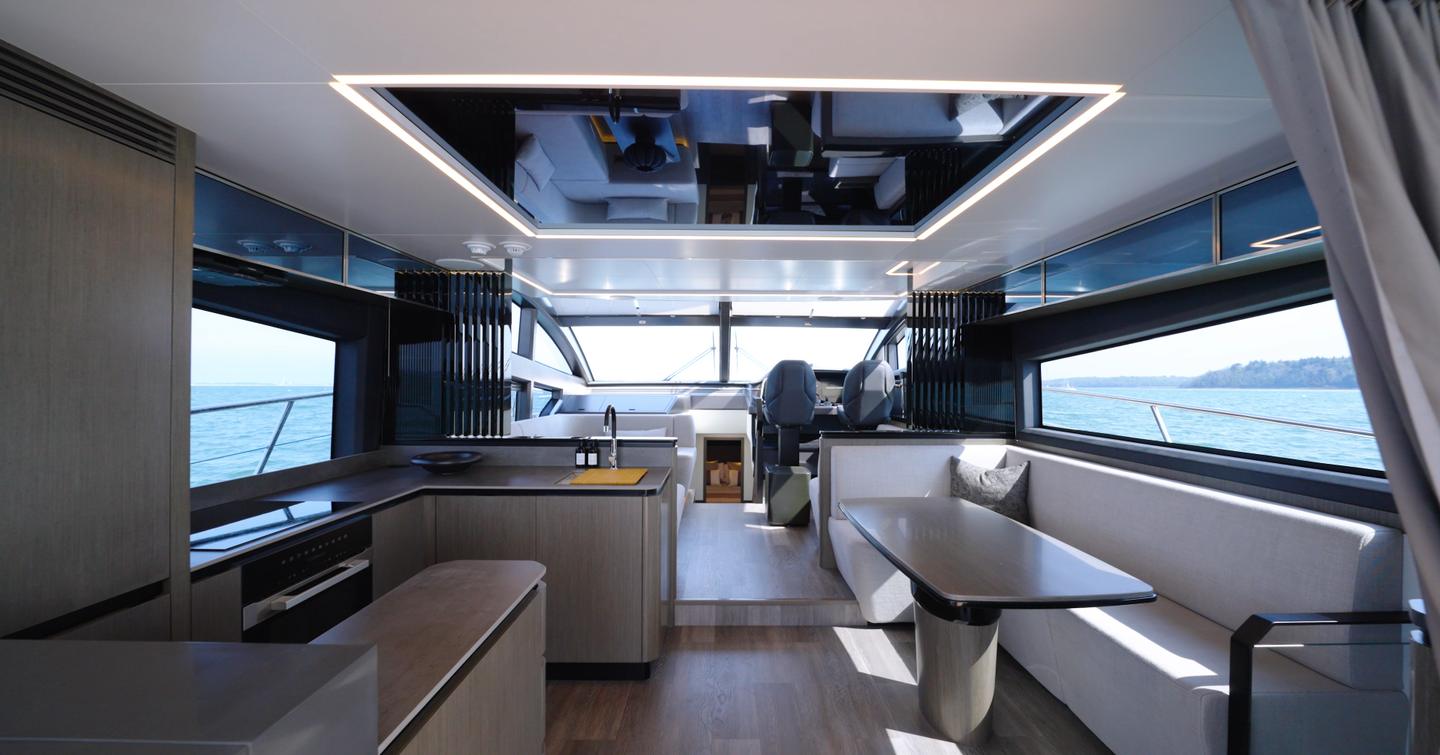
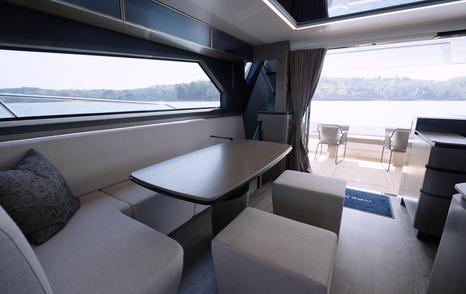
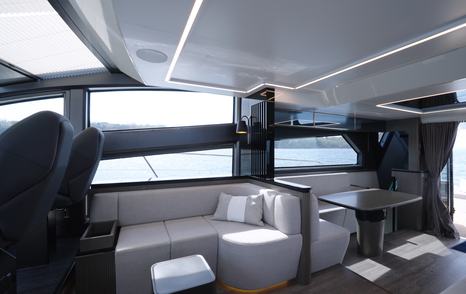
Move forward and the mood shifts - this is the lounging area, with lower, more reclined seating that’s designed for relaxing. The shape signals it - you’d sit here with a drink in hand, maybe watching TV from the pop-up unit tucked opposite. There’s nice ambient lighting throughout, and the design continues to feel considered.
The angled styling lines that break up the exterior glazing are visible from the inside too. They limit the size of the window panes compared to something like a Princess F58, but they give the yacht a distinctive profile from the outside, and with the extended windscreen and full-height glass panels, the saloon still feels bright and open.
That practical thinking carries right through to the forward end of the saloon. There’s a gas-ram assisted switch panel that opens easily, housing controls for the generator, air conditioning, and the Fusion audio system. Either side of that are deep lockers for stowing covers, spare cushions, or kit for the helm. And above it, there’s even more storage.
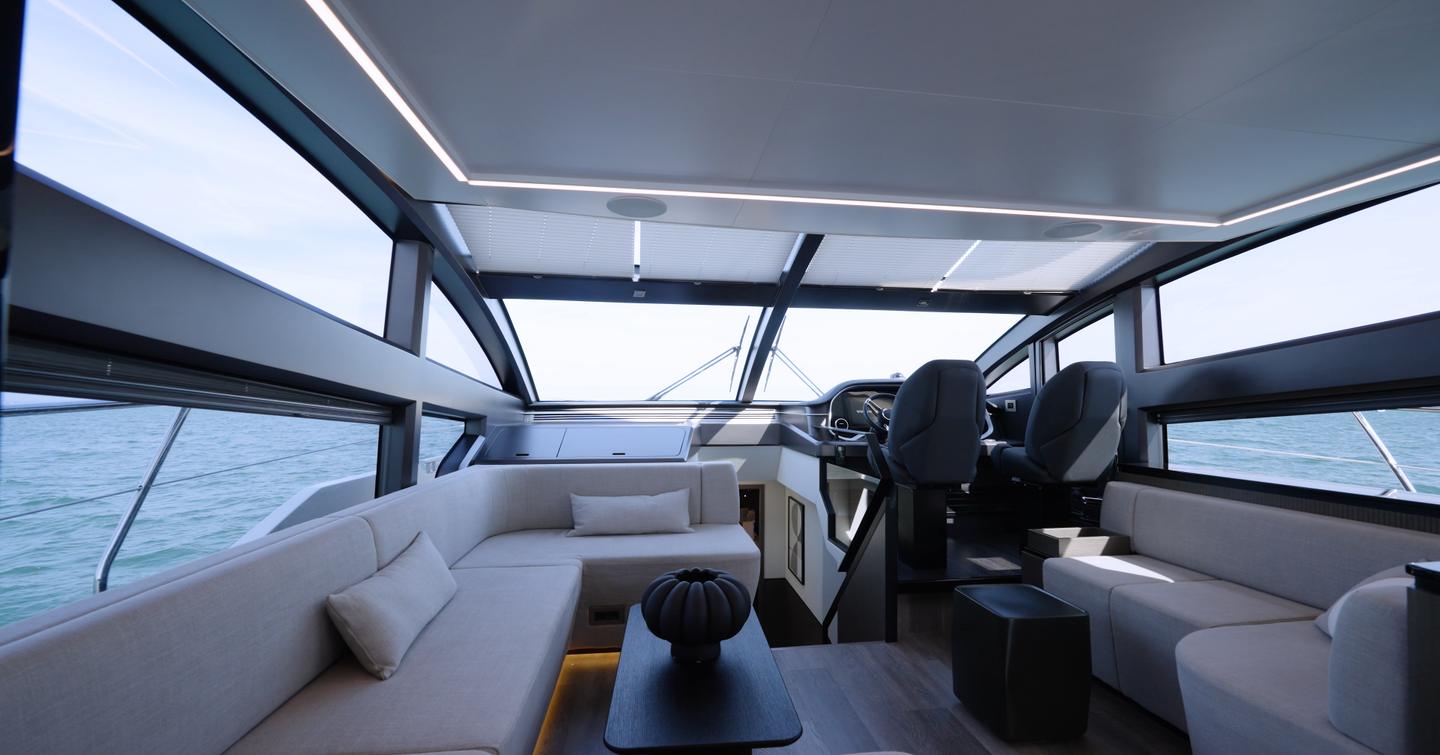
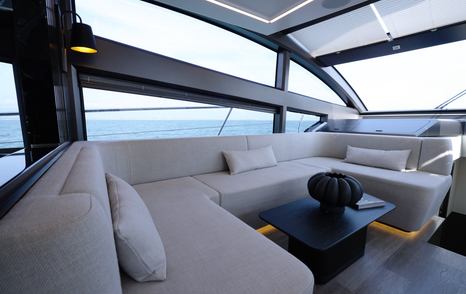
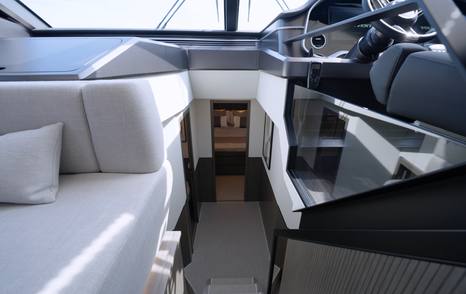
Owner’s Cabin
When the 62 was developed to replace the 60, the design moved away from the full aft cabin concept toward a more traditional layout, but still aimed to preserve a separate, private feel. That’s where the dedicated staircase at the aft end of the saloon comes in, leading directly down to the owner’s space. It’s fairly steep, though a full-length handrail has been fitted to help with the descent.
The space then opens into a private lobby area, leading into the cabin itself. It’s a generous, welcoming space, and the influence of Kelly Hoppen is immediately felt. The piano black finishes are used sparingly - likely because they’re high maintenance - but they make a strong impact where they appear. The wall behind the bed is particularly distinctive, giving the whole room a residential, rather than nautical feel.
While the styling is bold, it’s not at the expense of functionality. The bedside units are neatly done, with repeater switches, reading lights, power sockets, and extra storage all integrated.
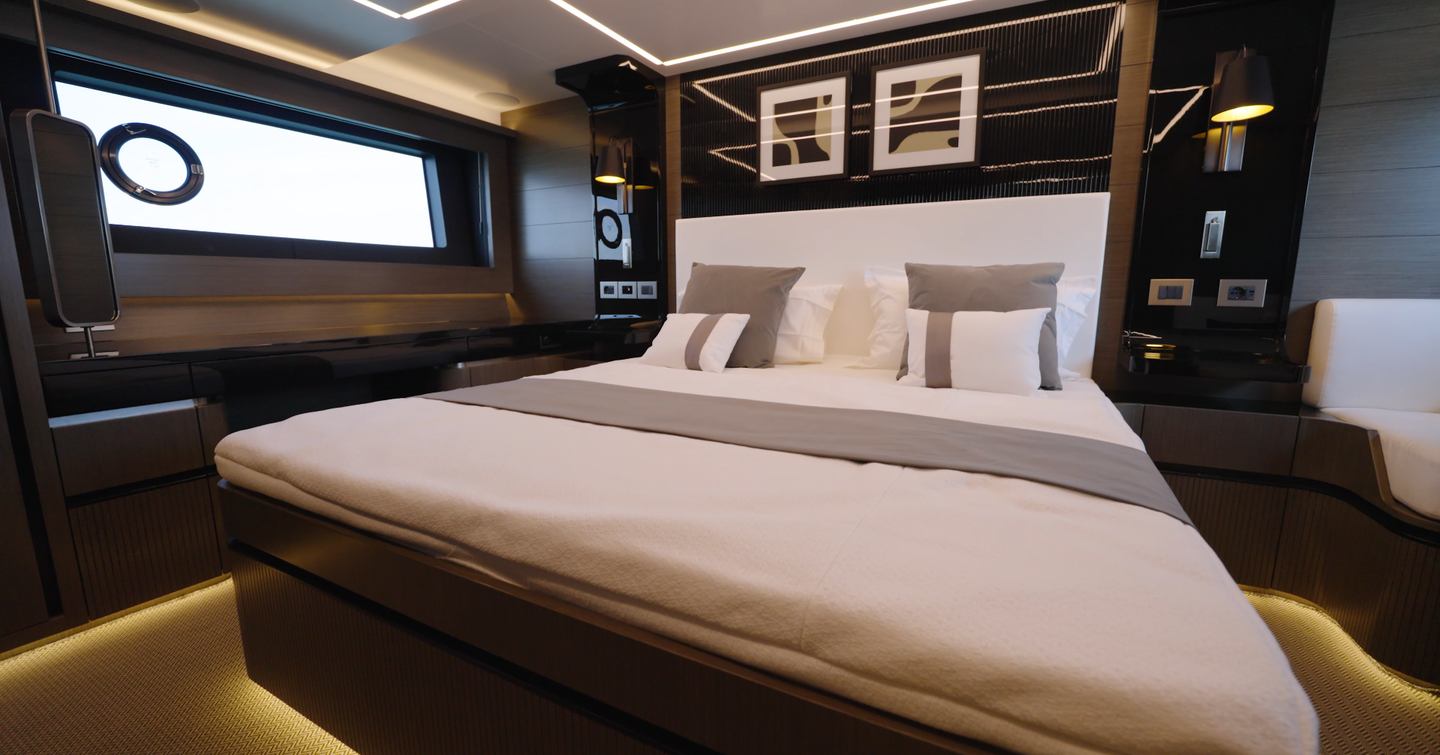
There's flexibility with the layout too – either a sofa or breakfast dinette opposite the bed. The dinette setup works particularly well for those who like a quiet spot to work away from the main saloon, with plenty of natural light and hull windows perfectly positioned so you can lie in bed and see straight out over the water.
The lighting design is another strong point. Subtle strip lighting traces the perimeter, and the TV panel, mounted slightly off the bulkhead with backlighting, creates a floating effect that elevates the whole look. A beautifully finished bureau sits to starboard, with design cues that echo in the VIP cabin. Storage is well distributed too. There’s no under-bed space due to the tanks below, but you still get twin hanging wardrobes, drawer storage in the bureau, and more tucked under the bedside units.
The private en suite follows the same design, with a slightly more industrial finish that leans toward the sleek, minimal end of the spectrum. It’s perhaps a little cool in tone, but the layout is nice - a large shower cubicle with a rainfall head, and crucially, a decent hull window that brings in light to lift the otherwise grey palette. Despite the darker finishes, the combination of artificial and natural light keeps the space from feeling too enclosed.
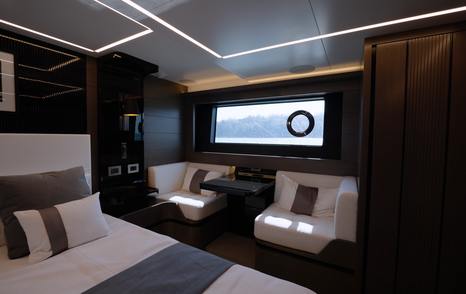

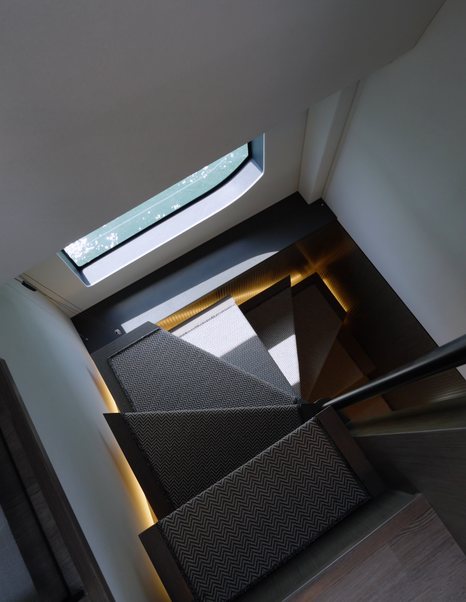
Guest Accommodation
The accommodation layout carries over from the Pearl 62, but it's that very setup that helps set the 63 apart from its rivals. Four double cabins, three bathrooms, and separate access to the owner's cabin, which gives a clear sense of privacy.
Guest cabins are located forward. The VIP suite sits right at the bow and is fully en suite. It's a bright, comfortable space with a generous bed set at a practical height and more headroom than you might expect. A pair of large hull windows flank the cabin, with additional glazing above, including a hatch above the bed, which lets in even more natural light once the sun pad is removed. The bed faces a TV discreetly mounted within a mirrored bulkhead, and there’s storage throughout, including hanging lockers on both sides, drawer storage beneath the bed, and a dedicated bureau with Pearl's distinctive rotating mirror feature.
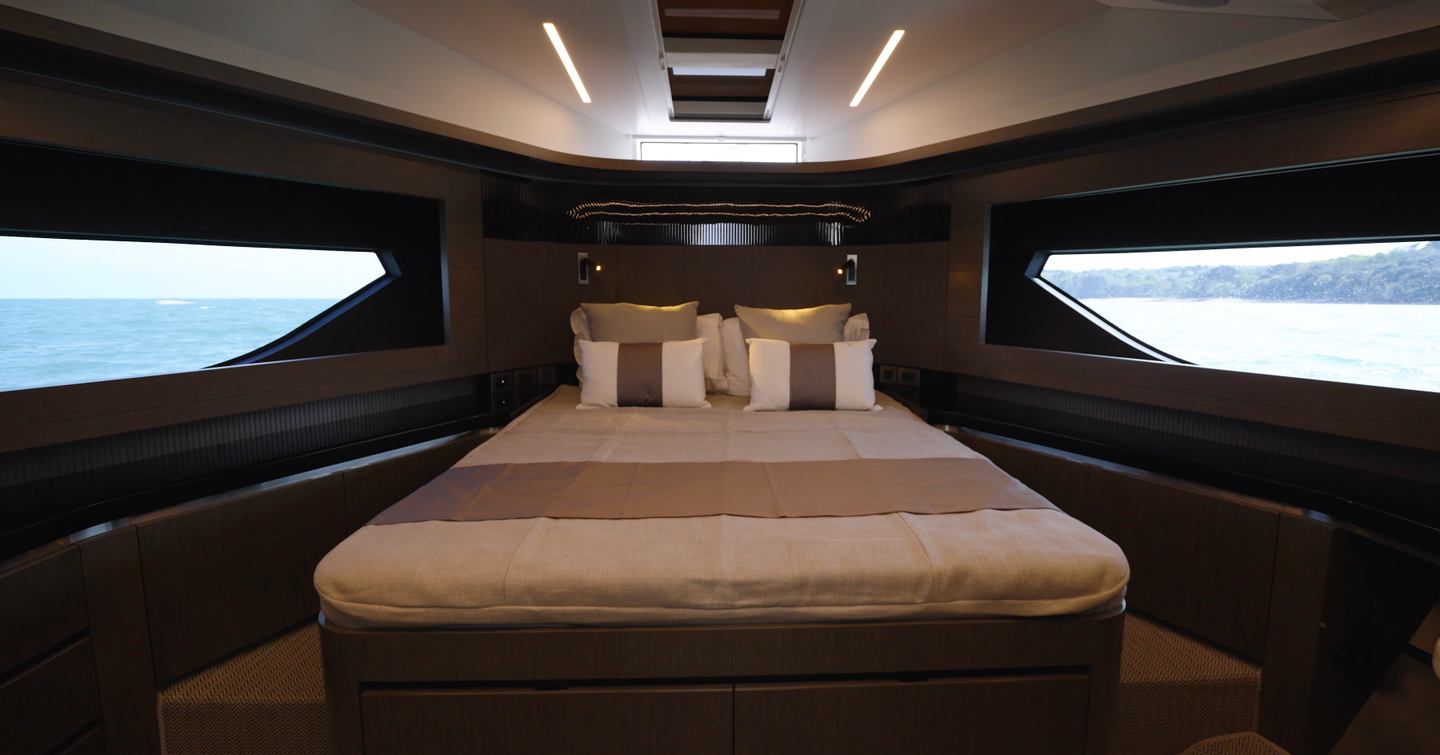
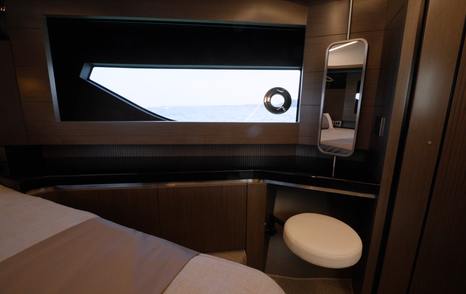
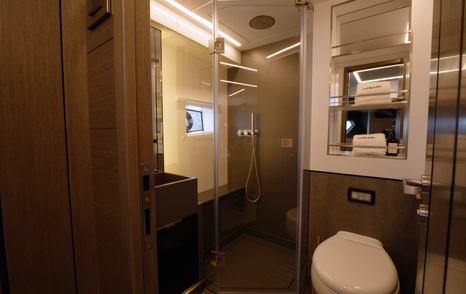
Moving aft, you’ll find two identical twin cabins, one to port and one to starboard. Both have good-sized berths, drawer storage beneath the beds, hull windows, and hanging lockers. The port-side cabin connects directly to the day head, which also serves the starboard twin at night. The headroom is handled cleverly - while it dips slightly where the overhead structure comes down, it opens up again toward the changing area and bathroom access.
The day head itself is well-sized, fitted with a large shower cubicle, rain shower, and powered extraction. Detailing throughout reflects the rest of the interior - calm tones, clean finishes, and practical use of space.
Feedback from Pearl 62 owners has clearly influenced the new model, particularly when it comes to storage. The 63 delivers across the board, with smart use of under-bed space, accessible drawers instead of lift-up panels, and a good mix of open and closed storage options throughout the guest accommodation.
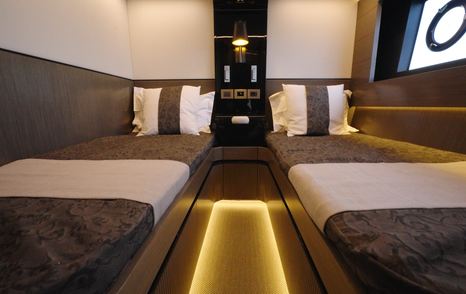
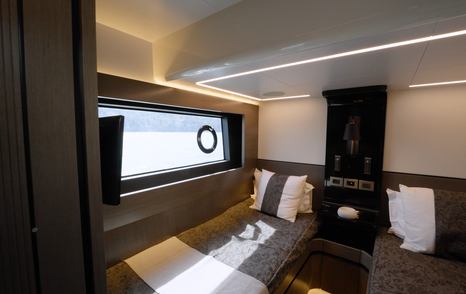
Upper Helm
At the upper helm, visibility is excellent, though the shallow windscreen could use a pop-up deflector - something like what Sunseeker or Absolute use - to push the wind up and over. But otherwise, it’s a pleasant setup. The throttles are mounted low, the seat slides forward, and the MFDs are upright and easy to read. The mushroom-coloured dash material looks clean and smart, without the glare or hairline scratches you often get from black GRP. There’s decent storage, cup holders, a comfortable seat with a footrest, and overall, it’s a properly sorted helm.
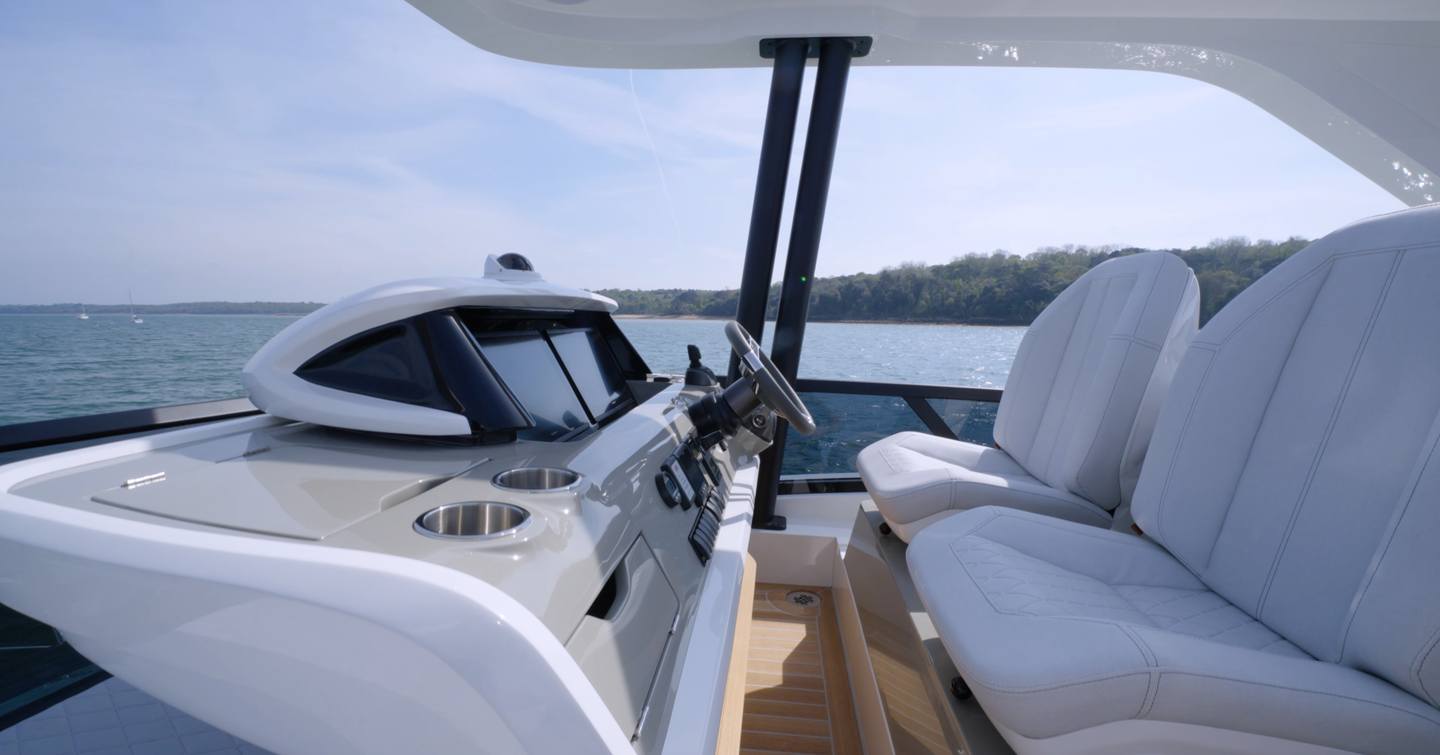
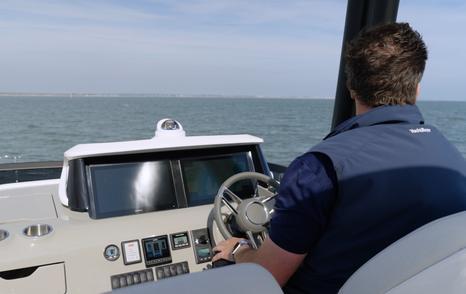
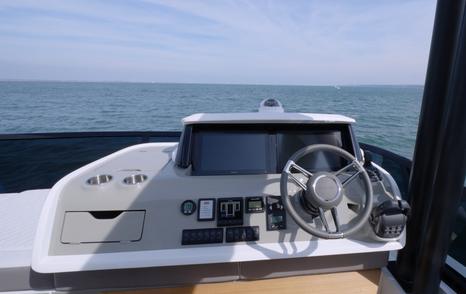
Lower Helm
The lower helm is where you do your longer passages or night cruising. Naturally, there’s more engine noise down here with no wind to mask it, but the sound insulation and IPS setup keep things well under control. The helm is offset just inboard of the centreline, reducing blind spots and offering good all-around awareness, especially with the addition of a quarter-light window on the starboard side. The finish is smart, understated, and free from excess gloss and therefore glare. The air vents do let the side down, though, even the cheapest city cars have classier-looking vents in their dashboard these days.
The windscreen wraps overhead, which makes the space feel bright and open without losing the sense of separation from the outside. There are blinds for glare and heat, and while the ergonomics aren’t quite as tight as the upper helm, everything is within reach. The seat slides, the wheel’s set well forward, and again it’s a comfortable driving position. The screens are further away than above, but upright and clear.
There’s space for a navigator and enough room between the seats for people to pass without disruption. The helm seat includes a bolster, so it’s easy to stand and lean if preferred. Visibility aft is more limited, especially on the port side, due to the galley and sliding lines, so you’ll be relying on the crew there. On the starboard side, you’ve got a door, which helps with situational awareness.
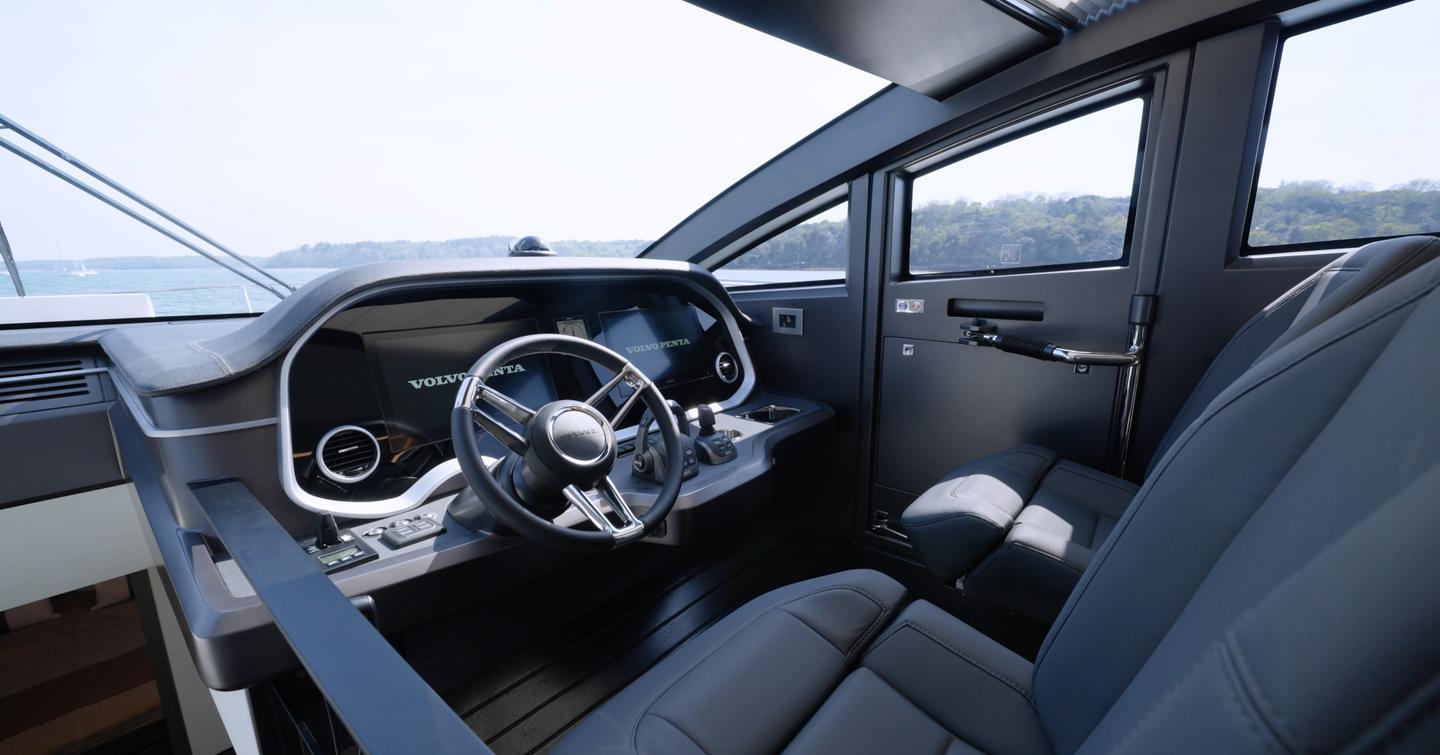
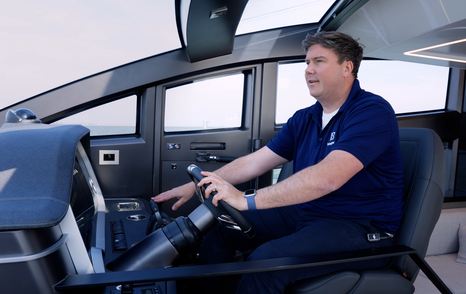
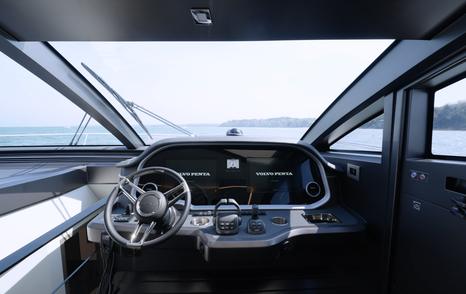
The 63 carries over the same tender garage setup as the 62, but with a bit more space to play with. That slight size increase means it can now accommodate a semi-inflated Williams MiniJet inside the garage - a step up from the 62, where it was a Jet Ski only, with the tender typically stored on the platform.
On the 63, you've still got options. You can run a tender and a toy - one in the garage, one on the platform - or go for just the tender and keep it tucked neatly out of sight. It does need to be partially deflated, but they’ve fitted a Scanstrut compressor inside the garage to make inflating and deflating the tubes faster.
It’s a smart design, and the platform plays a key role in how the system works. It extends out first, creating a step around the transom for walk-around access, then lowers into the water for launch and recovery.
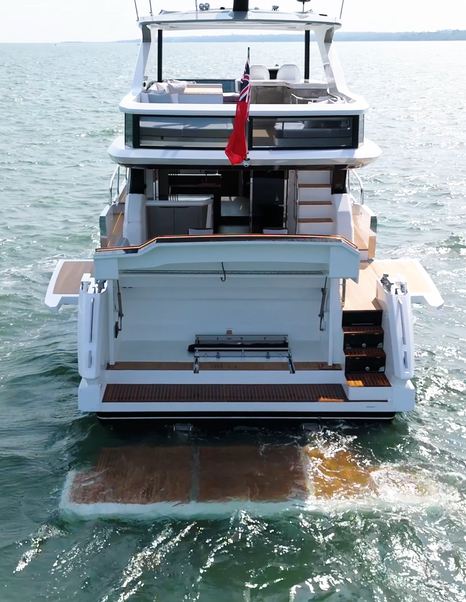
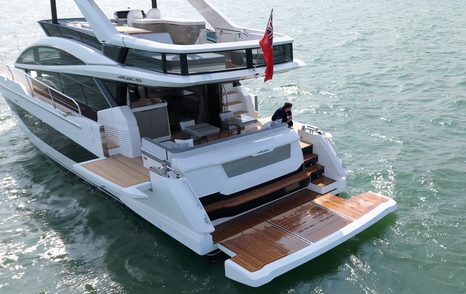
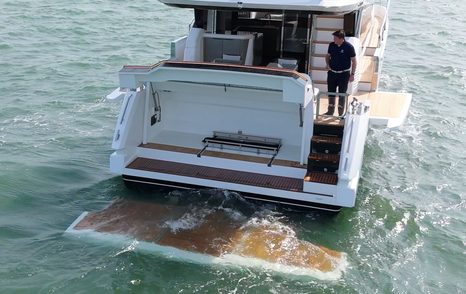
There’s a deck shower, along with hatches for access to shore power connections. If a passerelle is on the spec list - and it probably will be if stern-to-mooring is on the cards - that slots into the hatch on the top step. It’s a hydraulic unit, extending straight out when needed.
Like the 62, there’s the option to add a crew cabin, though it’s rarely chosen. Out of the 25 62s sold, only four were built with one. The design leans towards owner-operator use, but the option is there if you’re happy to trade the tender garage. Access to the crew space comes via a hatch here. Due to the shape of the transom, access to the main deck is limited to the starboard side, but the staircase is nice and easy to use.
Another standout feature on the 63 - and something the 62 didn’t offer - is the addition of balconies. Not a first, of course, but in this particular size and segment, it's a notable move. The balconies are a cost option, and the design is simple with no glass inserts or boarding gates, but even so, they bring genuine value. At anchor, opening these out changes the whole feel of the cockpit - it creates a stronger connection to the water, opens up the view, and gives kids and adults alike a bit more space to enjoy themselves.
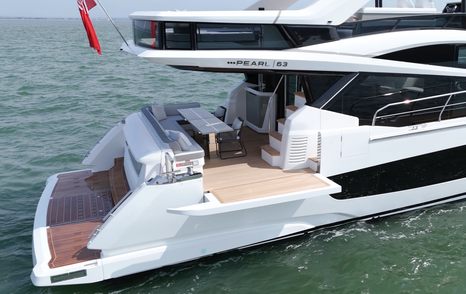
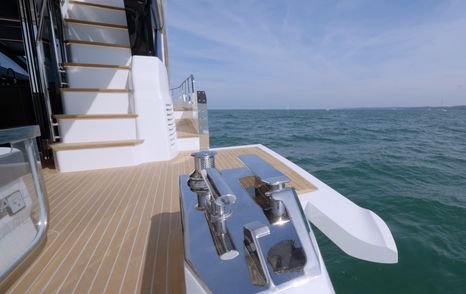
Side Decks & Foredeck
There are boarding gates on both sides, and while the side decks are slightly on the narrow side, they’re still manageable. What helps is the high guardrails - solid, well-positioned, and easy to grab. The gauge of the railings feels reassuringly substantial. Nice touches continue with the way functional elements like fuel fillers and waste ports have been worked into the tops of the bulwarks. Our test boat had full teak decks, and there’s also a side door - a feature that’s especially useful on an owner-operated yacht, giving the skipper quick, direct access from the helm to the deck.
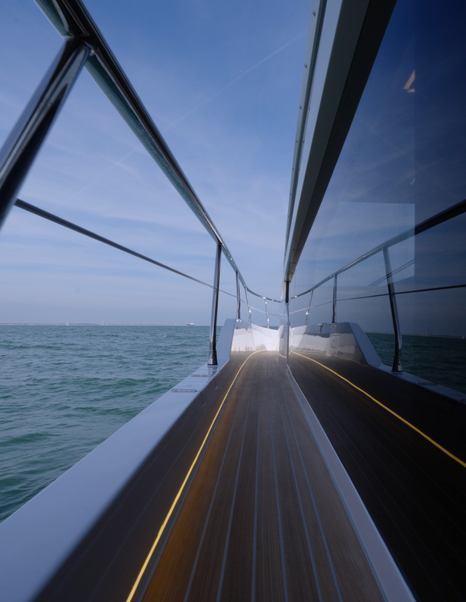
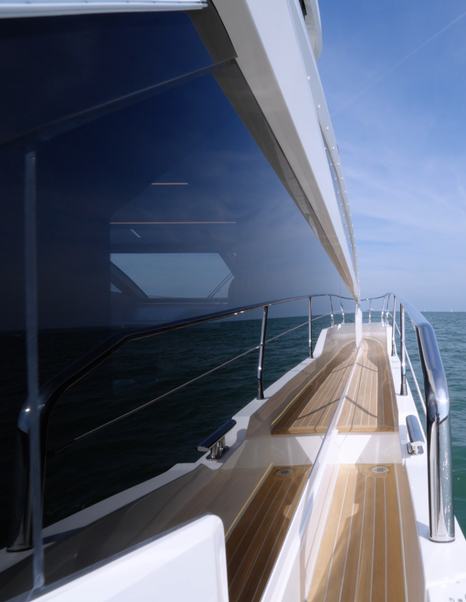
Up on the foredeck, the layout mirrors that of the Pearl 62. It’s a design that clearly worked well first time round - no reason to fix what isn’t broken. Beneath a flush hatch sits a fold-out dining table, large enough for relaxed meals forward. The sunpad features pop-up backs for added comfort, and there’s the option to set up a canopy using deck-mounted poles if shade is needed. Storage is generous too - deep, joined lockers capable of taking all the covers and lines, with proper volume and useful access.
There’s a thoughtful mix of detail up here - cup holders, pop-up lights, and a recessed space to drop your phone or smaller bits while you’re stretched out. Rather than dotting the deck with pin lights, they’ve gone for a continuous strip of lighting that runs all the way back to the cockpit - something that’s worked well on previous models, and it does the job here too.
Forward, the chain locker is well laid out - segmented for fenders and lines, with a tidy rack system that keeps ropes clear of the windlass. The Ultra Marine anchor is a premium bit of kit, backed up by chunky cleats and integrated fairleads.
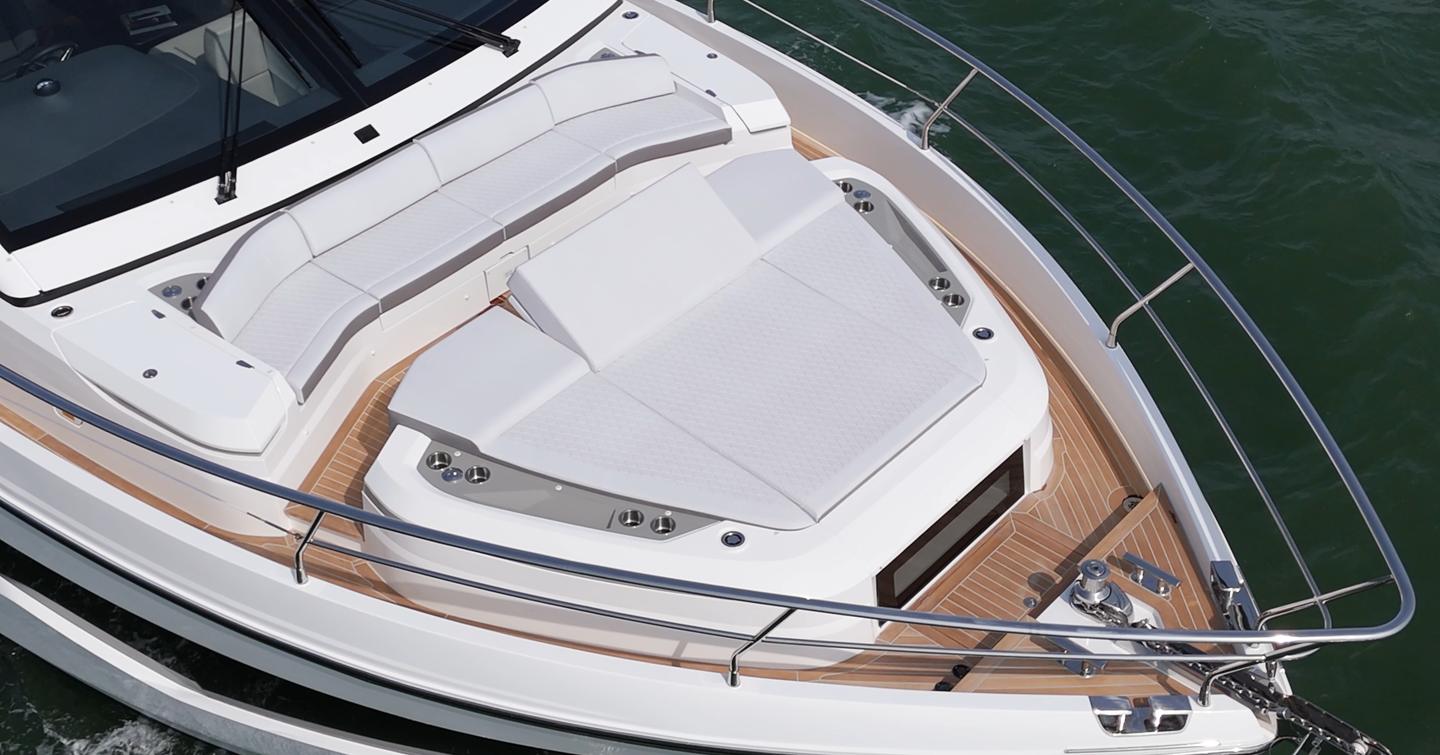
Cockpit and Docking Features
The cockpit is packed with smart, user-focused touches. One of the key options here is the third docking station, tucked neatly to port. On an IPS-driven boat, the inclusion of a joystick makes tight manoeuvring a breeze, especially when mooring stern-to-something you’ll likely be doing a lot of if you're spending time in the Med. There’s also a bow thruster repeater, and from this position, visibility is excellent - clear sightlines to the bathing platform, the quayside, and forward along the deck.
Practicality is built in throughout. A boat hook is stowed right at hand, perfect for picking up lazy lines. There’s a Fusion stereo repeater and a bit of tidy storage under the seating, including space for wine glasses, which feels like a nice, unexpected detail to find outside.
They’ve also made changes to the cockpit layout, particularly the seating. There are now split tables, and the backrest on the port side isn’t fixed, so it can be shifted to open up views across the balcony. Feet up, facing the water - it’s a lovely spot to sit. Around the cockpit, the backrests are on the lower side, and slightly set back, so they’re a touch more relaxed than upright dining seats. Still, the tables themselves are excellent - a smart folding design that opens and connects in one movement, creating a proper dining setup.
It works well either way - compact and tucked out of the way when underway, or expanded when you want to entertain. With additional chairs on the starboard side and a clear connection to the aft galley via drop-down windows, it’s a well-thought-out area that’s been designed with real usability in mind.
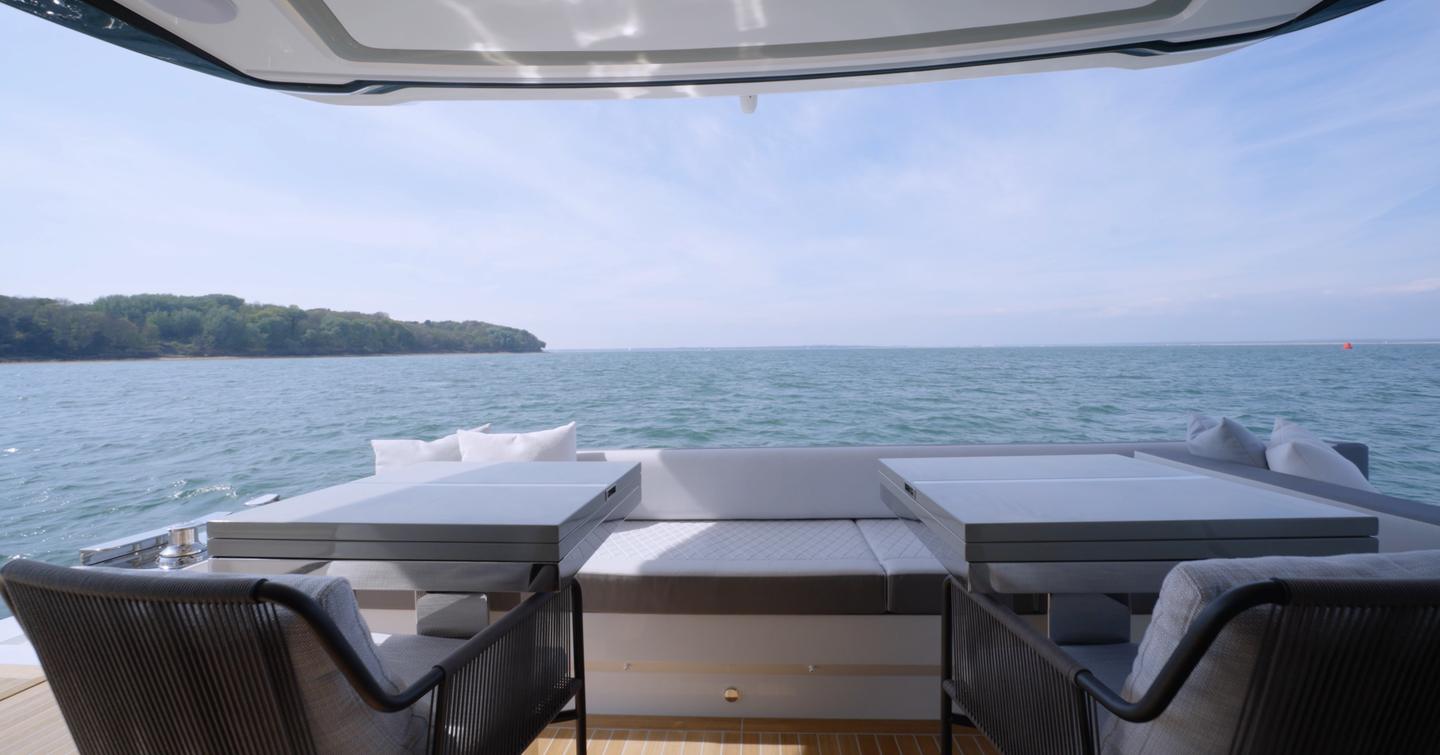
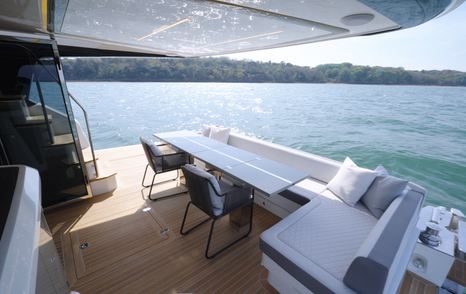
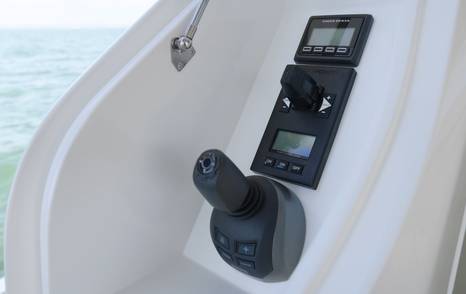
Flybridge
The layout stays close to the flexible formula used on the 62 - and that’s not a bad thing. You can go for an all-sunpad arrangement, or a mix of sunpad and seating as seen on our test boat. Like the deck below, there are movable stools that can be repositioned as needed, and there’s useful storage beneath, including space for the life raft. The hardtop is relatively shallow, which means no integrated bimini system - it’s manual, but still provides effective shade, even if it’s not quite as slick as the automated options. The roof opens right back to create a generous aperture, while still keeping the central seating area shaded, regardless of position.
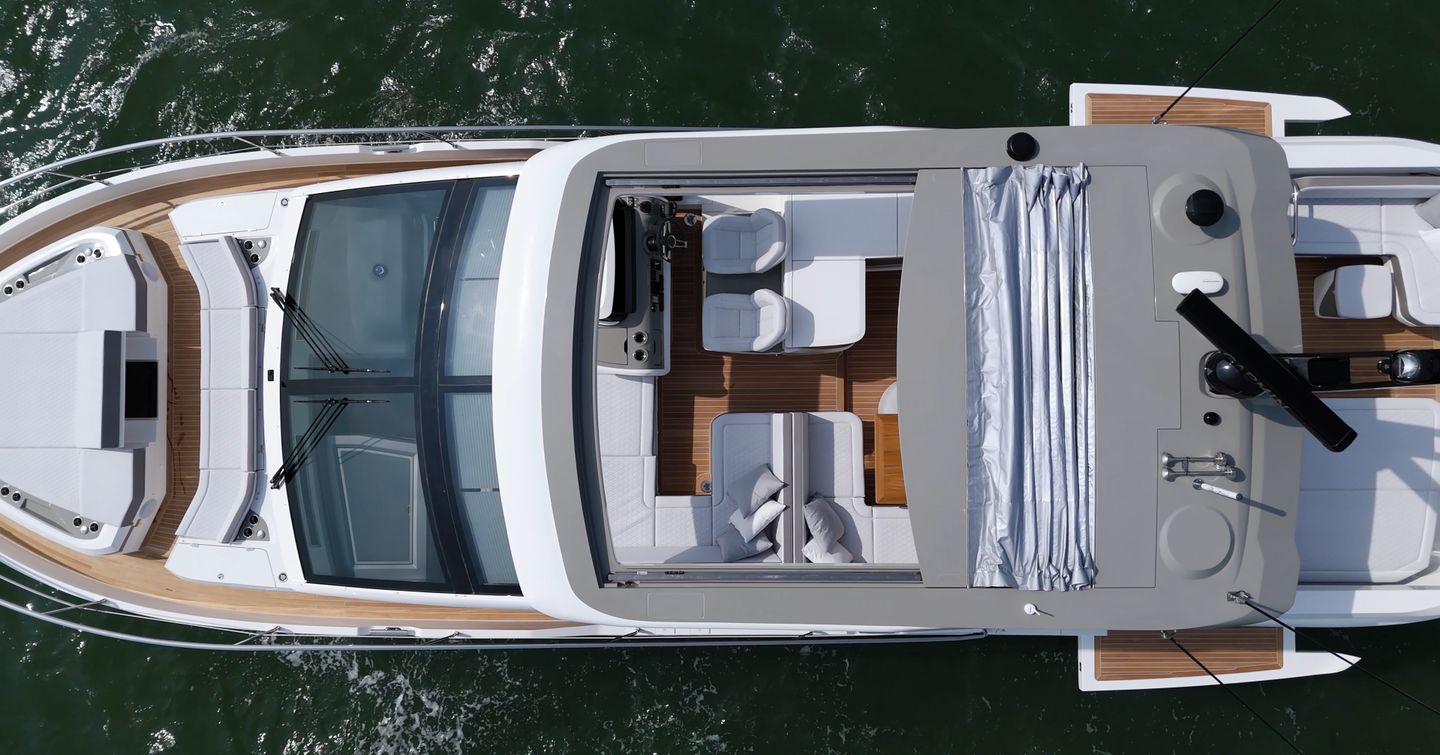
Amidships sits a well-specced wet bar, with the grill, sink, and top-loading fridge included as standard. This example adds a Vitifrigo fridge below and has space for an ice maker too. There’s plenty of space here for dining and entertaining, with deep cushions and flexible seating modules that can be reconfigured to suit.
Up at the front on the port side, the layout mirrors the 62 again, with seating that converts into a sunpad. One small update is the switch from stainless steel to black finishes on several key details, including the windscreen frame. It’s a subtle shift, but it gives the boat a cleaner, more modern look from the outside.
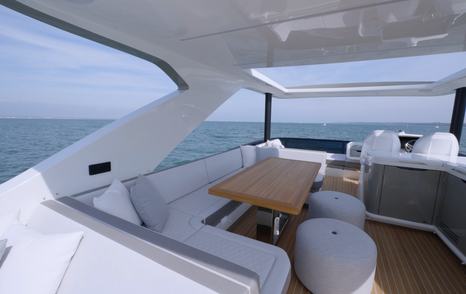
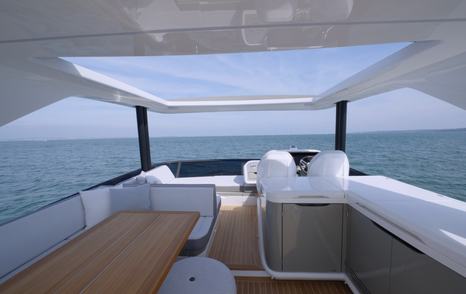

Pearl has always offered impressive value for money in comparison to its rivals. Building the boats in China is a cost-effective way to produce them, and that saving is passed on to the consumer. There's no evidence of corner-cutting, either. We only spent a day with the boat, but I'd challenge you to find areas where the boat looks or feels cheaper compared to its European-built rivals.
The base price for the 63 is £1,770,720 ex VAT (prices correct at time of writing).
All of these boats use the same engines/electronics/domestic appliances anyway, so you're not going to notice any difference when it comes to the components on board.
However, like every boat in this sector, the base price and the price you pay for an on-water package are two different things. That said, Pearl does include as standard items such as a hydraulic bathing platform, Humphree interceptors, bow thruster, 13.5kw generator, 2 x Garmin MFDs, the AV package, and a fully fitted flybridge wet bar.
For context, our test boat, which was a well-specified Mediterranean package, came in at £2,547,015 ex VAT.
Below are some options that we think are worth considering if you're looking to specify a Pearl 63.
Our Options & Pick
Every single Pearl 62 sold had the largest engine options, and it would be sensible to spec the biggest IPS1350s (£125,800), both for their performance and what buyers will be after if the boat goes on to the secondhand market. Adding Volvo's DPS, which holds the boat in place using the IPS pods and GPS (£27,720) and the third station in the cockpit (£7,591), makes a lot of sense if you're going to run the boat yourself.
The tender garage (£16,388) is unique in the market and a good option, and the flybridge hard top is a must-have too. It costs £55,209 but does at least come with a fabric sunroof as part of that. The folding balconies are an eye-watering £52,580 option (a lot given they don't even have glass in them), but they do make a big difference to the feel of the cockpit when they're deployed. The side door at the helm shouldn't be an option (but it is), and we think it's £15,200 well spent.
If you want air-con (96,000 BTU) - and most will - it will cost £33,990, and you'll also need to upgrade to the 20.5kw generator for £8,253. On that note, the Seakeeper SK9 gyro is a £129,900 option that will make a huge difference to comfort on board when you're at anchor.
Our Verdict
Has Pearl improved on the 62? Yes – in all the ways that matter.
The layout’s still excellent, but now there’s space for a proper tender in the garage. The cockpit balconies add flexibility, and the extra engine power lifts the top end just enough. These are small changes, but they add up.
It’s not without caveats. If you don’t need four cabins, rivals with three and a study might suit you better. And if you’re not keen on IPS, there’s no shaft-drive option here.
But for those who want space, style, and thoughtful design, this feels like the new benchmark. Bill Dixon has done it again.
Reasons to Buy
- Four double cabins
- Tender garage
- Unique interior design
- Strong performance
- Value for money
Things to Consider
- View from the lower helm
- Small crew cabin
- IPS only
Looking to own a Pearl 63 ? Use YachtBuyer’s Market Watch to compare all new and used Pearl 63 Yachts for sale worldwide. You can also order a new Pearl 63 , customized to your exact specifications, with options for engine choice and layout configuration. Alternatively, explore our global listings of new and used yachts for sale and find your perfect yacht today!
Rivals to Consider
The Pearl 62, shares much of its DNA with the 63, including a four-cabin layout that sleeps eight guests and uses the same IPS engine options. It’s slightly smaller overall, and while it maintains a high standard of finish, it doesn’t have the 63’s private stairwell to the master or the same expansive sense of volume. It’s also one of the most efficient yachts in the Pearl range, with a strong blend of performance and practical family cruising capability.
The Prestige 630 offers a three-cabin layout, accommodating up to six guests, with each cabin featuring private head and shower compartments. The full-beam owner's suite, accessed via a private stairwell, provides a sense of seclusion and luxury. Powered by twin Volvo Penta IPS 950 engines, the 630 achieves a cruising speed of 24 knots and a top speed close to 30 knots. Its design emphasises spaciousness and light, with large windows and an open-plan saloon enhancing the onboard ambience. While the Pearl 63 offers an additional cabin, the Prestige 630 focuses on expansive living areas and a seamless indoor-outdoor flow.
The Absolute 60 Fly features a three-cabin configuration, accommodating six guests, with the master stateroom uniquely positioned at the bow, offering panoramic views through large hullside windows. The yacht's innovative design includes modular furniture and extensive glazing, creating a bright and customisable interior. Equipped with twin Volvo Penta IPS 950 engines, it reaches a top speed of 28 knots.
The Azimut Fly 62 presents a three-cabin layout for six guests, with a distinctive "Beach Cockpit" at the stern that transforms into a sunbathing area, enhancing the connection to the sea. The yacht's design, characterised by sleek lines and large windows, offers a contemporary appeal. Powered by twin Volvo Penta IPS1350 engines, it achieves a top speed of 32 knots. While the Pearl 63 provides an extra cabin and a more traditional layout, the Fly 62 stands out for its innovative outdoor spaces and stylish design.
The Princess F58 accommodates six guests across three cabins, including a full-beam master suite with a walk-in wardrobe and en-suite bathroom. Its design incorporates features from larger yachts, such as a spacious flybridge and a foredeck terrace with adjustable sun pads. With a top speed of 35 knots, it offers impressive performance. Compared to the Pearl 63, the F58 has a blend of performance and luxury within a slightly more compact footprint, appealing to those seeking a balance between speed and comfort.
Considering a new yacht? Explore Pearl's entire current range to find the model that best suits your needs, and compare it with alternatives from competitors to ensure you make the perfect choice.
Specifications & Performance
- Builder Pearl Yachts
- Model Pearl 63
- Length Overall 61.056ft
- Beam 17.159ft
- Draft 5.217ft
- Hull GRP
- Cabins 4
- Berths 8
- Crew 1
- Yacht Type (Primary) Flybridge
- Use Type (Primary) Weekending
- Cruising Speed
- Max Speed
- Fuel Capacity 726 Gallons
- Fresh Water Capacity 211 Gallons
- Engine Model 2x Volvo Penta D13-IPS1350
- Engine max range (speed type) 260 (nm)
Interested in a Pearl 63?
NEW Build
Find your local dealer for a personalised, no-cost consultation
or just request
Brochures & Pricing
Used & In Stock
Looking for a ready-to-go Pearl 63 or pre-owned options? Explore all inventory of the Pearl 63 available worldwide
